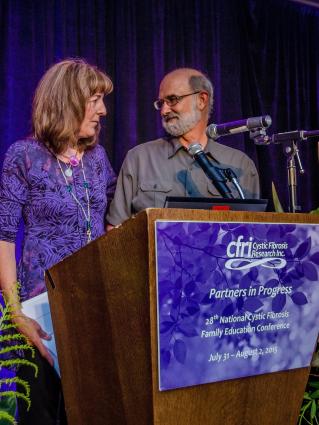Lab engineer lauded for work with cystic fibrosis
 (Download Image)
Lab engineer Doug Modlin (left) meets with two people with cystic fibrosis, along with Alisa Evans, a longtime Cystic Fibrosis Research, Inc. volunteer. Photo credit Craig Burleigh Photography.
(Download Image)
Lab engineer Doug Modlin (left) meets with two people with cystic fibrosis, along with Alisa Evans, a longtime Cystic Fibrosis Research, Inc. volunteer. Photo credit Craig Burleigh Photography.
Editor's Note: During the HOME Campaign, Public Affairs will run a series of articles about Lawrence Livermore National Laboratory employees who volunteer for various nonprofit agencies.
______________
A prominent and influential Bay Area nonprofit that provides funding for cystic fibrosis research recently handed a Lawrence Livermore Lab employee its top award for volunteer work.
Palo Alto-based Cystic Fibrosis Research Inc. (CFRI) in August gave this year’s Dave Stuckert Memorial Award to Lab Chief Electronics Engineer Doug Modlin for his more than 30 years of volunteering as a member of the CFRI Research Advisory Committee, including 10 years as chairperson, in addition to his past two years on the board of directors. Since joining the board, Modlin has chaired the organization’s strategic plan committee and CF research strategic plan committee. His work has ultimately led to revising the group’s annual CF research grant program by increasing monetary awards and revamping its policies.
"It’s really gratifying," Modlin said. "I’ve been able to utilize some of the basic skills and knowledge of processes I use in my work at the Lab as a volunteer for a really great cause. It feels like an extension of what we do here at the Lab for the good of society. It was a great honor to receive the award."
CFRI is among the nonprofits employees can choose to donate to in the Lab’s Helping Others More Effectively (HOME) Campaign, an employee charitable giving drive, which kicked off Thursday, Oct. 29 and runs through Dec. 4.
Modlin, whose daughter Anna was born with the life-threatening genetic disease, joined the nonprofit in the 1980s when it had just a handful of members, mostly parents of children stricken with cystic fibrosis.
"He’s a very thoughtful and analytic individual, and he’s brought those skills to creating our first long-term strategic plan and to updating and revising our CF research program so we’re keeping up with the needs of the (cystic fibrosis) community and the CF research community," said CFRI’s Executive Director Sue Landgraf. "He just never stops. I don’t know how we’d get along without him."
CFRI, which provides funding for research, as well as educational and personal support, and spreads awareness of the genetic disease, began in 1975. In 40 years, it’s grown from a small group of parents of children with CF to an organization of more than 15,000 households, agencies, medical facilities and other groups, raising hundreds and thousands of dollars every year for CF research. Donations have directly led to discoveries that were instrumental in the development of drugs targeted at restoring defective proteins that cause the disease.
Today, thanks to a double-lung transplant and some of the very advances in care that spawned from CFRI-backed research, Modlin’s daughter is doing well, and is an accomplished swimmer, setting multiple records and winning five medals in the 2013 World Transplant Games.
"Cystic fibrosis affects multiple organ systems in the body, but its effects on the lungs are life-limiting," Modlin said. "I had an engineering background so of course I wanted to do anything I could to help. I learned as much as I could about the biology underlying cystic fibrosis and used my engineering research background to strengthen CFRI’s peer review process and research funding policies."
Last year, the nonprofit donated nearly $500,000 to cystic fibrosis research and has given out more than $9 million since its inception.
"Our tiny but mighty organization is proud of its achievements," Modlin said. "I encourage my colleagues in Engineering and across the Lab to donate to the Lab’s HOME Campaign charities. CFRI is a great example of how a small group of dedicated volunteers and donors can bring about significant improvements in care for a life-threatening disease."
Contact
 Jeremy Thomas
Jeremy Thomas
[email protected]
(925) 422-5539
Related Links
Cystic Fibrosis Research, Inc.Lawrence Livermore National Laboratory Community Giving
World Transplant Games Federation
Tags
Community OutreachHOME Campaign
Featured Articles








